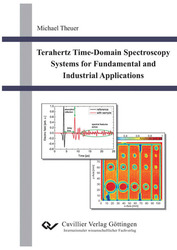| Areas | |
|---|---|
| Serie de libros (96) |
1378
|
| Nachhaltigkeit |
3
|
| Gesundheitswesen |
1
|
| Letra |
2363
|
| Ciencias Naturales |
5406
|
| Matemática | 229 |
| Informática | 319 |
| Física | 980 |
| Química | 1363 |
| Geociencias | 131 |
| Medicina humana | 243 |
| Estomatología | 10 |
| Veterinaria | 108 |
| Farmacia | 147 |
| Biología | 835 |
| Bioquímica, biología molecular, tecnología genética | 121 |
| Biofísica | 25 |
| Nutrición | 45 |
| Agricultura | 1004 |
| Silvicultura | 201 |
| Horticultura | 20 |
| Ecología y conservación de la tierra | 148 |
| Ciencias Ingeniería |
1791
|
| General |
98
|
|
Leitlinien Unfallchirurgie
5. Auflage bestellen |
|
Erweiterte Suche
Terahertz Time-Domain Spectroscopy Systems for Fundamental and Industrial Applications (Tienda española)
Michael Theuer (Autor)Previo
Indice, Datei (34 KB)
Lectura de prueba, Datei (380 KB)
The terahertz (THz) band between 100 GHz and 10 THz is particularly interesting for a wide range of applications since it unifies the properties and advantages of the adjoining spectral ranges, the infrared and the millimeter waves. But unfortunately in this spectral range the optical as well as electronic systems can not offer a sufficient performance in terms of power and sensitivity. So in both approaches, new sources and detectors are developed to expand the accessible electromagnetic spectrum into the THz range.
In this thesis new developments in the field of optical THz systems for THz time-domain spectroscopy (TDS) are investigated using femtosecond pulses for the coherent generation and detection. New schemes for THz emitters are elaborated. The main aim is to obtain a THz source with high output power in the frequency range between 100 GHz and 4 THz for femtosecond pumped systems. In a cooperation with the RIKEN Institute in Japan an enhancement cavity for the pump radiation is developed. This is an actively stabilized synchronously pumped ring resonator which recycles the unused pump radiation.
As THz emitter a lithium niobate crystal in Cherenkov-type geometry is applied. Lithium niobate is particularly well suited as a THz emitter because of its high nonlinearity, high transparency in the near infrared and the well developed poling technique. To guarantee an efficient broadband surface emitting scheme also for long crystals an attached silicon prism is used as THz output coupler. The enhancement cavity is characterized in terms of properties for the near infrared pump pulses as well as for the emitted THz radiation.
So far most of all THz-TDS systems are based on pulsed lasers with wavelengths around 800 nm. In order to apply readily available femtosecond fiber lasers at 1.5 μm wavelength, used e. g. in the telecommunication field, new materials for THz emitters have to be investigated. Here results of various emitters based on different semiconductors with pump wavelengths up to 2 μm are presented.
For the application of THz radiation different TDS systems are realized. Limiting factors like laser power, pump wavelength, flexibility, space consumption and imaging optics are addressed. Portable systems and fiber based systems are constructed. A special emphasis is placed on a THz imaging system, which is used in feasibility studies for industrial customers.
Results of industrial relevant measurements are presented. The recorded THz electric field is typically evaluated in terms of amplitude and phase. This shows a THz image underlining different properties of the device under test. Potential applications are in the field of non-destructive testing and final inspection (geometry, thickness, coatings, interfaces). The detection limit in the time domain is demonstrated for thin layers and calibrated samples.
THz spectroscopy also can give the “spectral fingerprint”, an important decision criterion for the sample to be identified (content, substance distribution). Simulants as well as real world explosives and poisons are measured. The advantages of THz time-domain spectroscopy compared to cw or passive THz systems are discussed. A balanced discussion of the possibilities and limitations for THz stand-off detection is given.
http://www.physik.uni-kl.de/beigang
| ISBN-10 (Impresion) | 3869550597 |
| ISBN-13 (Impresion) | 9783869550596 |
| ISBN-13 (E-Book) | 9783736930599 |
| Idioma | |
| Numero de paginas | 174 |
| Edicion | 1 Aufl. |
| Volumen | 0 |
| Lugar de publicacion | Göttingen |
| Lugar de la disertacion | TU Kaiserslautern |
| Fecha de publicacion | 27.07.2009 |
| Clasificacion simple | Tesis doctoral |
| Area |
Física
|








